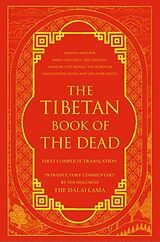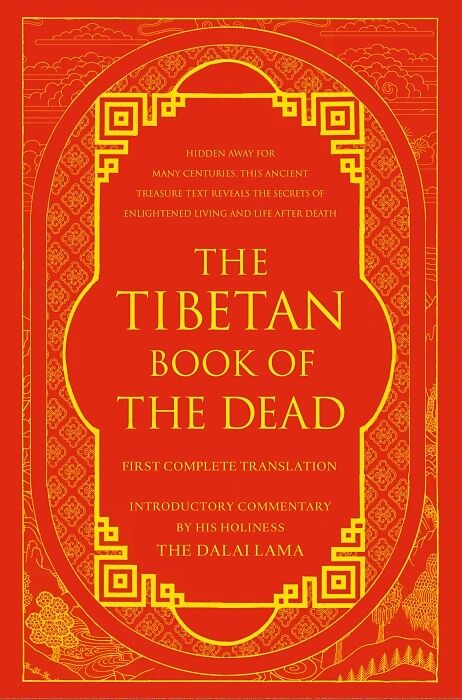The Tibetan Book of the Dead
Einband:
Fester Einband
EAN:
9780670858866
Untertitel:
First Complete Translation
Genre:
Religion & Theologie
Autor:
Gyurme Dorje, Graham Coleman, Thupten Jinpa
Herausgeber:
Random House N.Y.
Anzahl Seiten:
592
Erscheinungsdatum:
19.01.2006
ISBN:
0670858862
One of the greatest works created by any culture and overwhelmingly the most significant of all Tibetan Buddhist texts in the West, The Tibetan Book of the Dead has had a number of distinguished translations, but none encompassed the work in its entirety. Now, in one of the year''s most important publishing events, the entire text has not only been made available in English but in a translation of quite remarkable clarity and beauty.With an introductory commentary by His Holiness The Dalai Lama, who calls this translation "an extraordinary accomplishment undertaken with great care over many years" this complete edition faithfully presents the insights and intentions of the original work. It includes one of the most detailed and compelling descriptions of the after-death state in world literature, exquisitely written practices that can transform our experience of daily life, guidance on helping those who are dying, and an inspirational perspective on coping with bereavement. Translated with the close support of leading contemporary masters, including HH Dilgo Khyentse Rinpoche, and learned scholars such as Khamtrul Rinpoche and Zenkar Rinpoche, His Holiness the Dalai Lama says, "I hope that the profound insights contained in this work will be a source of inspiration and support to many interested people around the world."
"This new translation of The Tibetan Book of the Dead is a tremendous accomplishment." -Francesca Fremantle, Buddhadarma magazine"Profound and unique, it is one of the great treasures of wisdom in the spiritual heritage of humanity." -Sogyal Rinpoche, Author of the Tibetan Book of Living and Dying
Autorentext
Gyurme Dorje, Ph.D., is a leading scholar of the Nyingma tradition of Tibetan Buddhism. Thupten Jinpa, Ph.D., is the senior translator to His Holiness The Dalai Lama and president of the Institute of Tibetan Classics.
Klappentext
Reflecting the insights and intentions of the original work, this text includes one of the most detailed and compelling descriptions of the after-death state and practices that transform the experience of daily life and the process of dying.
Leseprobe
The question of whether or not there exists a continuity of consciousness after death has been an important aspect of philosophical reflection and debate from ancient Indian times to the present. When considering these matters from a Buddhist point of view, however, we have to bear in mind that the understanding of the nature of continuity of consciousness and the understanding of the nature of the ‘I’ or ‘self’ are closely interlinked. Therefore, let us first look at what it is that can be said to constitute a person.According to Buddhist classical literature, a person can be seen as possessing five interrelated aggregates, technically known as the five psycho-physical aggregates.a These are the aggregate of consciousness, the aggregate of form (which includes our physical body and senses), the aggregate of feeling, the aggregate of discrimination, and the aggregate of motivational tendencies. That is to say, there is our body, the physical world and our five senses, and there are the various processes of mental activity, our motivational tendencies, our labelling of and discrimination between objects, our feelings, and the underlying awareness or consciousness.Among the ancient schools of thought, which accepted the notion of continuity of consciousness, there were several non-Buddhist philosophical schools which regarded the entity, the ‘I’ or ‘self’, which migrated from existence to existence as being unitary and permanent. They also suggested that this ‘self’ was autonomous in its relationship to the psycho-physical components that constitute a person. In other words they believed or posited that there is an essence or ‘soul’ of the person, which exists independently from the body and the mind of the person.However, Buddhist philosophy does not accept the existence of such an independent, autonomous entity. In the Buddhist view, the self or the person is understood in terms of a dynamic interdependent relationship of both mental and physical attributes, that is to say the psycho-physical components which constitute a person. In other words our sense of self can, upon examination, be seen as a complex flow of mental and physical events, clustered in clearly identifiable patterns, including our physical features, instincts, emotions, and attitudes, etc., continuing through time. Further, according to Prāsaṅgika-Madhyamaka philosophy, which has become the prevailing philosophical view of Tibetan Buddhism today, this sense of self is simply a mental construct, a mere label given to this cluster of dependently arising mental and physical events in dependence on their continuity.Now, when we look at this interdependence of mental and physical constituents from the perspective of Highest Yoga Tantra,b there are two concepts of a person. One is the temporary person or self, that is as we exist at the moment, and this is labelled on the basis of our coarse or gross physical body and conditioned mind, and, at the same time, there is a subtle person or self which is designated in dependence on the subtle body and subtle mind. This subtle body and subtle mind are seen as a single entity that has two facets. The aspect which has the quality of awareness, which can reflect and has the power of cognition, is the subtle mind. Simultaneously, there is its energy, the force that activates the mind towards its object - this is the subtle body or subtle wind. These two inextricably conjoined qualities are regarded, in Highest Yoga Tantra, as the ultimate nature of a person and are identified as buddha nature, the essential or actual nature of mind.Now, before we look more closely at the nature of the subtle body and mind, let us look at how the gross body and mind are thought to originate. The notion of dependent origination lies at the very heart of Buddhist philosophy. The principle of dependent origination asserts that nothing exists in its own right independent of other factors. Things and events come into being only in dependence on the aggregation of multiple causes and conditions. The process through which the external world and the sentient beings within it revolve in a cycle of existence propelled by karmic propensities and their interaction with misapprehension, attraction and aversion and conditions is described in terms of twelve interdependent links. Each cycle of the process begins with a misapprehension of the nature of actual reality. This fundamental ignorance acts as a condition for the arising of the propensities created by our past actions, mental, verbal and physical, which condition our dualising consciousness. Our dualising consciousness, in turn, conditions the qualities and mode of interaction of our psycho-physical aggregates, which condition our sensory fields, which generate contact, which generates sensations, and then in turn attachment, grasping, and maturation towards rebirth. At this point there is an interaction with the genetic constituents of the parents and subsequent interaction with the environment, and then finally we have birth, ageing and death. This cycle can be viewed as both illustrating the underlying processes of life, death and rebirth and as an illustration of the processes to be transformed on the path to liberation from suffering in cyclic existence.The notion that there is a connection between this life and the events of both our previous existence and our future existence, follows from the Buddhist understanding of the natural law of cause and effect. For example, although we can speak of yesterday’s weather and today’s weather as distinct, today&…

Leider konnten wir für diesen Artikel keine Preise ermitteln ...
billigbuch.ch sucht jetzt für Sie die besten Angebote ...
Die aktuellen Verkaufspreise von 6 Onlineshops werden in Realtime abgefragt.
Sie können das gewünschte Produkt anschliessend direkt beim Anbieter Ihrer Wahl bestellen.
Loading...
Die aktuellen Verkaufspreise von 6 Onlineshops werden in Realtime abgefragt.
Sie können das gewünschte Produkt anschliessend direkt beim Anbieter Ihrer Wahl bestellen.
| # | Onlineshop | Preis CHF | Versand CHF | Total CHF | ||
|---|---|---|---|---|---|---|
| 1 | Seller | 0.00 | 0.00 | 0.00 |
